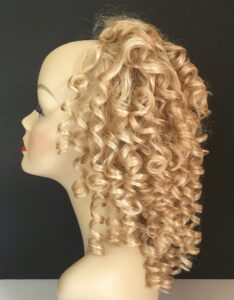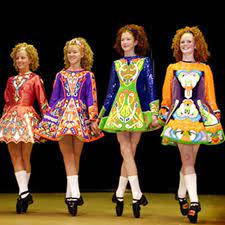Irish step dancing is a unique and fascinating form of traditional Irish dance characterized by its quick, precise footwork and graceful, fluid movements. Lets look at the history of Irish step dancing, the significance of its costumes, wigs, music, and footwear, and its relationship to Irish dancing as a whole.
Irish Step Dancing – A Brief History
The origins of Irish step dancing can be traced back to the 18th century when traveling dance masters journeyed throughout Ireland to teach dance in rural communities. These dance masters were well-respected and highly sought after for their expertise in teaching various dance forms, including the precursors to modern Irish step dancing. As they traveled from village to village, they imparted their knowledge and skill, helping to shape the unique style that would become Irish step dance.
In the 19th century there was a large shift in Irish dance culture as the Gaelic League encouraged the formalization of Irish dance. The Gaelic League was an organization dedicated to preserving and promoting Irish language and culture, This led to the establishment of the first official Irish dance competitions, known as feiseanna, in the late 19th and early 20th centuries.
Irish step dance experienced a resurgence in popularity in the 1990s, thanks in large part to the success of shows like Riverdance and Lord of the Dance. These performances showcased the incredible athleticism and artistry of Irish step dance, propelling it onto the world stage and inspiring a new generation of dancers and enthusiasts.
Irish Step Dancing Wigs
One of the most iconic aspects of Irish stepdance is the use of wigs, particularly in competitive performances. Traditional Irish stepdance wigs are made from synthetic materials, designed to mimic natural, curly hair. These wigs are a relatively modern addition to the Irish step dance costume and are often worn as a way to pay homage to the dancers’ Irish heritage.
In the early days of competitive Irish step dancing, female dancers would often spend hours curling and styling their hair to achieve the desired look. With the advent of wigs, dancers can now easily achieve a consistent, polished appearance without spending hours preparing their hair. While the use of wigs is not required, many dancers choose to wear them as a symbol of tradition and pride in their Irish heritage.

Irish Step Dancing Music
Music is an integral part of Irish step dance, with the rhythm and tempo of the music dictating the steps and movements of the dancers. Traditional Irish music is characterized by its lively, energetic melodies and distinctive instruments, such as the fiddle, tin whistle, and accordion.
Irish step dancing music is typically played in a 6/8 or 4/4 time signature, with jigs, reels, hornpipes, and slip jigs being the most common types of tunes used. The music is the driving force behind the particular dance moves, with dancers often moving in perfect synchrony with the beat, creating a mesmerizing display of rhythm and movement.
Irish Step Dancing Shoes
Footwear is crucial in Irish step dance, with different shoes being worn for different types of dances. There are two main types of Irish step dancing shoes: soft shoes (also known as ghillies or pumps) and hard shoes (also known as jig shoes or heavy shoes).
Soft shoes are made of soft leather and are similar in appearance to ballet slippers. They are worn by both male and female dancers for light dances, such as reels and slip jigs. Soft shoes allow for greater flexibility and ease of movement, enabling dancers to perform intricate footwork with precision and grace.
Hard shoes, on the other hand, are made of sturdy leather and feature a fiberglass or leather tip and heel, which produce distinctive clicking sounds when they strike the floor. These shoes are worn for heavy dances, such as hornpipes and treble jigs. The added weight and rigidity of hard shoes provide dancers with the ability to create complex rhythms and percussive elements through their footwork.
Irish Step Dancing Clothes
The costumes worn by Irish step dancers are as rich and varied as the dance itself. Traditionally, female dancers wear elaborately embroidered dresses, while male dancers don more subdued vests and trousers. The intricate designs found on these costumes often incorporate Celtic symbols and motifs, reflecting the deep cultural roots of Irish stepdance.
In more modern times, there has been a trend towards more modern and streamlined designs, with many dancers opting for simpler, less ornate costumes. However, the core elements of traditional Irish stepdance attire remain, with a strong emphasis on showcasing the dancer’s heritage and skill.
The color and style of the costume may vary depending on the dancer’s age, the level of competition, as well as personal preferencess. For example, younger dancers typically wear more modest, age-appropriate costumes, while older, more experienced dancers may choose to wear more elaborate and eye-catching designs.
Relation to Irish Dancing
Irish stepdance is a subset of the broader category of Irish dancing, which encompasses a wide range of traditional and modern dance styles from Ireland. In addition to Irish stepdance, other forms of Irish dance include set dancing, céilí dancing, and sean-nós dancing.
Set dancing and céilí dancing are both social forms of Irish dance, usually performed in groups and featuring lively, energetic movements. They differ from Irish stepdance in that they are less focused on intricate footwork and precision, instead emphasizing the communal and social aspects of the dance.
Sean-nós dancing, on the other hand, is an older, more improvised form of Irish dance. It is characterized by its low-to-the-ground footwork and subtle, expressive movements, often performed solo or in small groups. While sean-nós dancing shares some similarities with Irish stepdance in terms of footwork, it is considered a distinct and separate dance form.
Irish stepdance has evolved over the centuries, yet remains firmly rooted in tradition. From the ornate wigs and costumes to the rhythmic, percussive footwork, every aspect of this unique dance form serves as a celebration of Irish culture and identity.

